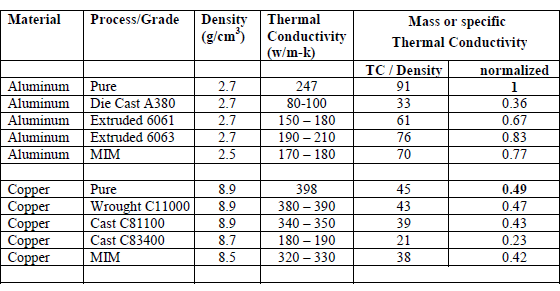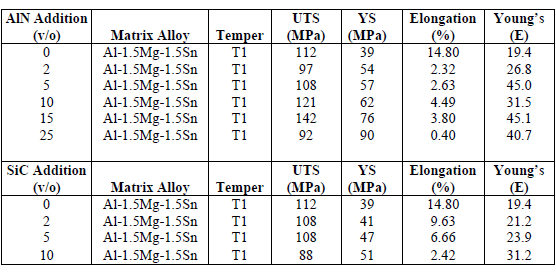New alloy developments enhance PM aluminium application opportunities, Part 2
The paper presented by Richard L Hexemer Jr. (GKN Sinter Metals) on behalf of his co-authors Ian Donaldson (GKN Sinter Metals) and Logan Smith and Paul Bishop (Dalhousie University) focussed on the potential of PM aluminium products in thermal management applications such as heat sinks.
Heat sink applications represent a large market for wrought and die cast aluminium products, on the basis of a 3 to 4 cost advantage compared with the primary competing material, copper. However, to date, this market opportunity has not been tapped by PM aluminium.
Although aluminium cannot match the thermal conductivity of copper per se, the weight of a heat sink is often a design consideration and the 3 to 1 density advantage of aluminium over copper means that it can be highly competitive on the basis of specific thermal conductivity.
Table 1 compares a range of aluminium and copper materials on the basis of this parameter, which, in the final column, is normalised to denote the value for pure aluminium as 1.
In order to achieve a high thermal conductivity in sintered aluminium products, it was deemed to be necessary to minimise or eliminate porosity (i.e. to achieve a sintered density as close as possible to full theoretical density) and to avoid those alloying additions that decrease TC. These criteria led the authors to concentrate their interests on a simple Al-Mg-Sn press/sinter system.
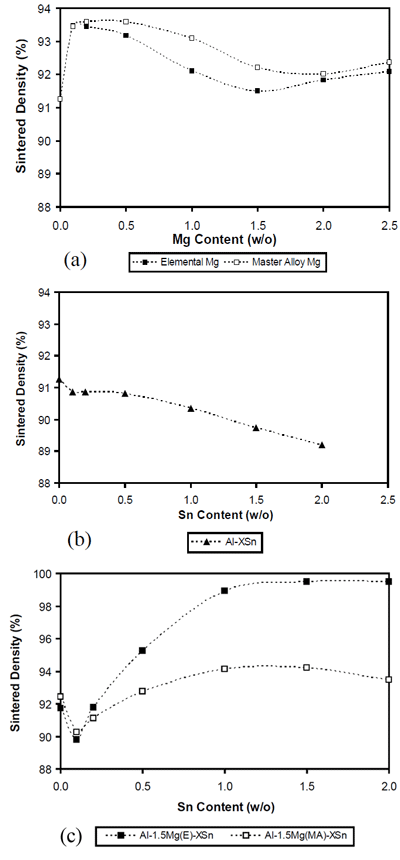
Fig. 1 Effects of Mg (a), Sn (b) and their combination (c) on the sintered density of aluminium PM compacts (data extracted by the authors from MacAskill et al) (Courtesy MPIF)
The studies of densification of a range of Al-Mg-Sn experimental mixes, summarised in Fig. 1, led to the conclusions that:
- Magnesium was more effective as an elemental addition than as a masteralloy
- Two alloy compositions, Al-1.5Mg-1.5Sn (wt %) and Al-1.0Mg-1.0Sn (wt %) should be selected for development. These two compositions were designated as PM TC2000-1.5 and PM TC2000-1.0 respectively.
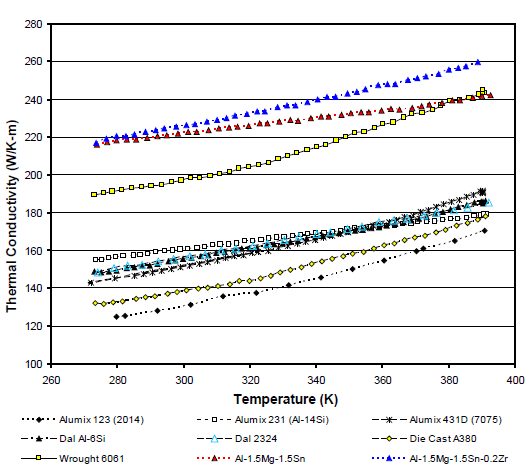
Fig. 2 Thermal conductivities of selected aluminium PM, wrought and die cast materials. (Courtesy MPIF)
Fig. 2 demonstrates that the first of these alloys provides thermal conductivity that is superior to the levels achievable with a range of standard wrought and die-cast aluminium materials.
This figure also shows that, if elevated temperature thermal conductivity is a significant design consideration, then this property can be further enhanced by the use of a Zr-prealloyed Al as the base powder for the alloy.
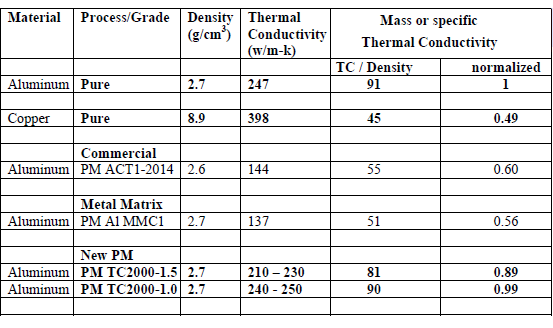
Table 2 Thermal conductivities of existing and the newly developed aluminium PM alloys (Courtesy MPIF)
The specific thermal conductivities of the newly developed alloys are compared with those of existing materials in Table 2. The data in this table demonstrate the superiority, in this context, of these alloys over established commercial PM aluminium grades and, indeed, the PM TC2000-1.0 grade offers the same TC as pure aluminium.
Two further property parameters have been considered in this development:
- Coefficient of thermal expansion (CTE) was measured for the new alloys and was found to be in line with pure Al. Further, previous work had shown that the level of this property could be lowered by the addition of ceramic materials that have low CTE. Lower CTE is a desirable attribute for heat-sinks when matching with low expansion substrates such as silicon.
- Tensile properties were measured on dog-bone test-pieces. These properties are presented in Table 3. Although, these properties are relatively low compared to established PM aluminium alloys, they are considered to be sufficient for heat sink applications. However, the incorporation of ceramic additions was again considered to be a potential means of improving these mechanical properties.
The addition of ceramics in two forms was therefore studied – a separate addition of silicon carbide (SiC) or the in-situ formation of aluminium nitride (AlN) during sintering.

Table 3 Tensile properties of Al-1.5Mg-xSn systems (data extracted by the authors from MacAskill et al) (Courtesy MPIF)
The results reported in Table 4 demonstrate that additions of up to 15% AlN bolster mechanical properties while simultaneously reducing CTE.
The influence of these ceramic additions on thermal conductivity of the new PM alloys is still under investigation but, given that the ceramic additions have intrinsically high thermal conductivity compared with aluminium, the authors have a high level of confidence that a beneficial influence will also be observed in this context, provided that a good interface between the reinforcement and the matrix is created.
Overall, it can be concluded that this work has provided GKN Sinter Metals with a new suite of PM aluminium grades, with which to attack this significant new market opportunity.
News | Articles | Market reviews | Search directory | Subscribe to e-newsletter



